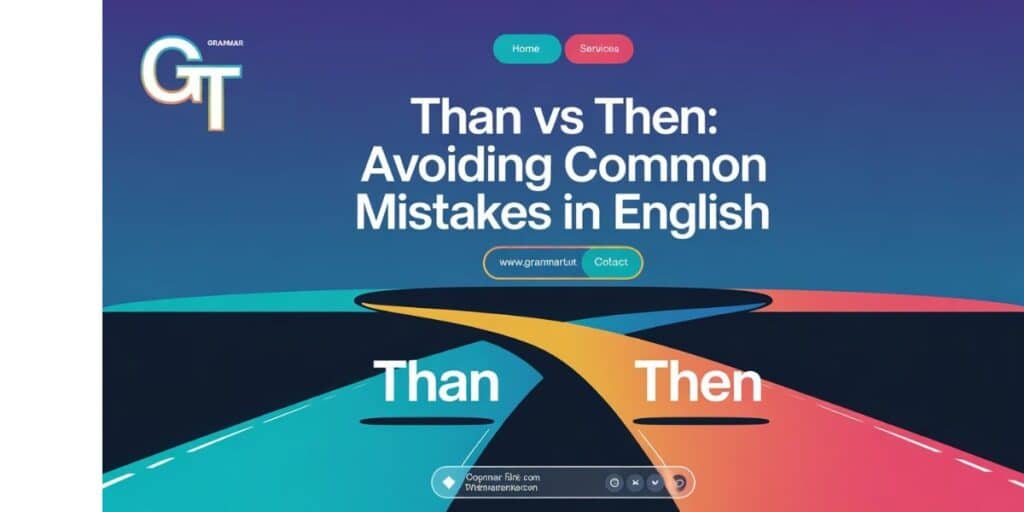Than vs Then: Avoiding Common Mistakes in English can trip up even the most confident writers. These two tiny words may look alike, but they serve very different purposes. Mixing them up can make your writing confusing—or even change the meaning entirely.
In this guide, you’ll learn the difference between than and then, and how to use each correctly. With simple examples and helpful tips, you’ll avoid the usual slip-ups and boost your grammar skills. Understanding this basic English rule will sharpen both your writing and your communication.
📘 Understanding the Basics
1️⃣ ‘Than’ vs ‘Then’: The One Letter Difference
2️⃣ Understanding the Meanings and Usage
🔹 The Meanings of ‘Then’ and ‘Than’
🔹 How ‘Then’ is Used
🔹 How ‘Than’ is Used
3️⃣ Pronouncing ‘Then’ and ‘Than’
🔸 Pronunciation Guides
🔸 Consistency Across Regions
🔸 Audio Examples
🧠 Avoiding Mistakes & Mastering Usage
4️⃣ Common Mistakes with ‘Then’ and ‘Than’
⚠️ Using “Then” Instead of “Than” in Comparisons
🕒 Using “Then” in Time Sequences
❗ Confusing “Since Then” vs “Since Than”
🔄 Using “Then” Instead of Other Words
5️⃣ Tips, Tricks & Reinforcement
🧩 Simple Memory Aids
🌍 Reinforcing with Indian Languages
6️⃣ Key Takeaways & Conclusion
✅ Quick Recap
📝 Final Thoughts
7️⃣ FAQs
💬 Frequently Asked Questions
Why Is There Confusion?
People mix up than and then because they look and sound similar. One compares; the other shows time or sequence. But even tiny words can trip you up when they serve totally different roles.
Most confusion happens in casual writing. Since they’re only one letter apart, it’s easy to swap them without noticing. That’s why it helps to slow down and double-check your work.
Must read: Oxymoron vs Antithesis: What’s the difference?
⚡ Quick Summary
Confusing than and then is one of the most common grammar slip-ups. Here’s the fix:
- ✅ Than = used for comparisons
📝 Example: She’s faster than him. - ✅ Then = used for time, sequence, or consequences
📝 Example: We ate, then left.
One compares, the other tells when. Simple rule, big impact. Mastering this one-letter difference will sharpen your writing and help you avoid everyday grammar mistakes with ease.
When to Use “Than”?
Use than when you’re comparing things. It’s a word that links two choices, like “taller than me.”
It often follows words like “more,” “less,” or “better.” For example, “She runs faster than I do.” It always shows contrast.
When to Use “Then”?
Use then when you’re talking about time or sequence. It tells what comes next, like “We went to dinner, then saw a movie.”
It can also mean “at that time” or even “in that case.” For example, “If you’re ready, then let’s go.”
Than vs Then: Uses
Than is all about comparisons. Then deals with time, steps, or results.
The key is function. Think of than as comparing and then as timing or consequence. Understanding their roles clears up confusion fast.
Common Mistakes
People often say “better then you” instead of “better than you.” It’s a small slip but makes a big difference.
These mix-ups show up a lot in texts and emails. Reading aloud can help you catch them before hitting send.
Other Than or Other Then?
Here’s where grammar trips people up. The right phrase is other than, not “other then.”
Other than is a comparison—it excludes something. “Other than chocolate, I love all sweets.”
Other Than
Other than “except for.” You’re pointing out something that doesn’t fit.
Example: “Everyone other than John was invited.” It’s always about contrast or exclusion.
Other Then
“Other then” isn’t standard usage. It only makes sense if you’re literally talking about time.
Like, “At no other then the scheduled hour did it happen”—but that’s rare and awkward.
More Than or More Then?
“More than” is correct when comparing quantities. Think “more than five people showed up.”
“More then” is almost always a mistake. If it doesn’t involve a sequence of events, it’s probably wrong.
More Than
Use more than for numbers, size, or preference. “I have more than enough.”
It’s a straightforward comparison, showing one amount exceeds another.
More Then
“More then” only works when it’s about time or steps. Like: “We ate, then walked, and more then followed.”
Even then, it’s clunky and rarely needed. Stick with more than for clarity.
Rather Than or Rather Then?
Always use rather than when choosing between two things. “I’d walk rather than drive.”
“Rather then” is incorrect. It just doesn’t work grammatically in comparison.
Rather Than
Rather than means you’d prefer one thing over another. It introduces a better choice.
Example: “I’d relax rather than rush.” Simple and correct.
Rather Then
“Rather then” tries to blend two meanings—and fails. It’s just not right.
You might see it, but don’t use it. Stick with it rather than every time.
Etymology of “Than” and “Then”
Both words come from Old English but evolved differently. That’s why their modern meanings split.
Than came from comparison roots. Then came time-related words.
Etymology of “Than”
The word than comes from the Old English “þonne.” It started as a comparative term.
Its role hasn’t changed much over centuries. It still links two ideas for contrast.
Etymology of “Then”
Then also comes from “þonne” but took on a time-based meaning.
Over time, it evolved to show sequence or consequence. That’s why we say, “Back then…”
The Difference Between ‘Than’ and ‘Then’
It’s easy to confuse than and then, but they aren’t interchangeable. Than is used when making comparisons. For example: “She’s taller than I am.”
On the other hand, then relates to time or sequence. You’d say, “We ate dinner, then watched a movie.” One word compares, the other tells when.
The Correct Usage of ‘Than’
Always use than when pointing out differences or preferences. It comes after words like more, less, better, or worse.
Examples include: “I’d rather stay home than go out” or “He’s more skilled than I expected.” If you’re comparing, than is the word you need.
Common Mistakes with ‘Than’
People often write “bigger then me” instead of “bigger than me.” That small swap changes the meaning—and not in a good way.
Another slip-up: “I’d prefer tea then coffee.” Sounds right, but it should be “than coffee.” Keep an eye out when comparing things.
Why It Matters
Using than and then incorrectly can hurt your credibility. It may seem like a small mistake, but readers notice.
In business, academics, or even texting, clarity counts. Getting this right helps you sound smarter, sharper, and more professional.
About Linguix Grammar Checker
Linguix is a powerful tool that spots grammar issues in real time, including than vs then mix-ups.
It not only corrects the mistake but explains why it’s wrong. Great for writers, students, or anyone who wants cleaner, more polished content.
Try Linguix for free and upgrade your writing instantly.
Comparison with ‘than’, e.g. ‘bigger then (than)’ mistake examples
Let’s clear this up with some examples:
- ❌ “He’s stronger then me.”
- ✅ “He’s stronger than me.”
- ❌ “It costs more then that.”
- ✅ “It costs more than that.”
Every time you’re showing a difference, than is the word you want. Then only works if you’re talking about time or order.
‘Then’ vs ‘Than’: The One Letter Difference
It’s just one letter, but it makes a huge difference. Then talks about time or sequence. Than is all about comparison.
Mixing them up might seem minor, but it can totally change what you’re trying to say. Knowing when to use each will instantly boost your grammar game.
You will like: Excel or Accel: What is the correct Spelling?
Understanding the Meanings and Usage of Then and Than
Let’s break down what these words really mean. Knowing their roles helps you avoid embarrassing mistakes.
Then and than sound similar, but they behave very differently in sentences.
1) The meanings of ‘then’ and ‘than’:
Then means something that happens next, or a consequence. Think about time or results.
Than is strictly for comparisons—one thing measured against another.
2) How ‘then’ is used:
Use then to show what happens afterward: “We ate, then went for a walk.”
It also works in conditional sentences: “If you call, then I’ll answer.”
3) How ‘than’ is used:
Use than when comparing: “This book is better than the last one.”
It links two choices, often with words like more, less, or rather.
Pronouncing ‘Then’ and ‘Than’
Even pronunciation can blur the lines. They sound alike in fast speech, which adds to the confusion.
1) Pronunciation Guides:
Than has a softer “a” like in “man.” Then has more of an “eh” sound, like in “pen.”
Say them slowly and clearly when learning the difference.
2) Consistency Across Regions:
In American English, the difference is subtle but still there.
Accents in different regions may blur it further. But even so, written context clears it up.
3) Audio Examples:
Want to hear it? Online dictionaries like Merriam-Webster have audio clips.
Practice by repeating after them. It’ll help your ear get used to the subtle change.
1) Using “then” instead of “than” in comparative sentences:
Mistake: “He’s faster then me.”
Fix: “He’s faster than me.”
Always use than when comparing. Period.
2) Using “then” instead of “than” in expressions of time or sequence:
This is the one time then is correct: “We met, then we talked.”
Don’t say “We met, than we talked.” That just sounds wrong.
3) Confusing “since then” and “since than”:
Only one of these is correct: “Since then, I’ve changed a lot.”
“Since than” isn’t a real phrase. Avoid it completely.
4) Using “then” instead of other words:
Sometimes people toss in then to fill space: “Well then, let’s go.”
It’s fine in casual speech, but don’t overuse it. Say what you mean with clarity.
Some Interesting Tips and Tricks
- Tip: If it’s comparing, go with than.
- Tip: If it’s about time, use then.
- Trick: Swap “in comparison to” or “next” into your sentence. If “next” fits, you need then. If “in comparison to” fits, go with than.
Reinforcing with Indian Languages
In many Indian languages, there’s a clearer split between comparison and time. For example, in Hindi:
- Comparison: “से (se)” acts like than.
- Time: “फिर (phir)” acts like then.
Recognizing this difference helps non-native speakers master the usage faster.
Key Takeaways
- Then = time, sequence, or results.
- Than = comparison, contrast, or choice.
- Don’t rely on how they sound—focus on their role in the sentence.
- Double-check tricky sentences. Mistakes often sneak into casual writing.
You will like: Feal vs Feel: Which One Should You Use?
Conclusion
Mastering the difference between Than vs Then is simpler than it seems, but it makes a big impact. Than is your go-to word for comparisons, while then fits when you’re talking about time or sequence.
Swapping one for the other can confuse your reader and muddy your meaning. Keep these roles clear, and your writing will instantly sound more polished and professional. Remember: compare with than, sequence with then. With practice and attention, you’ll avoid these common mistakes in English and communicate with confidence every time.
FAQ’S
What is the main difference between “than” and “then”?
Than is used for comparisons (e.g., “She is taller than me”), while then relates to time or sequence (e.g., “We ate, then left”).
Can “then” ever be used in a comparison?
No, then should never replace than in comparisons. Using then in this context is grammatically incorrect.
Why do people often confuse “than” and “then”?
They look and sound similar, especially when spoken quickly. That one-letter difference often leads to simple but common writing mistakes.
How can I remember when to use “than”?
Think of than as part of comparison to words like “more than” or “less than.” If you’re comparing two things, go with than.
Are “then” and “than” pronounced the same?
Not exactly. Than has a softer “a” sound, while then has a more open “e” sound. But in casual speech, the difference can be subtle.

Joulia, a seasoned wordsmith and grammar enthusiast, brings over a decade of blogging expertise to Grammar Tune. With a keen eye for linguistic precision and a passion for making complex grammar concepts accessible, he has helped thousands of readers enhance their writing skills. His engaging teaching style and practical approach to language learning have made him a trusted voice in the online grammar community.







